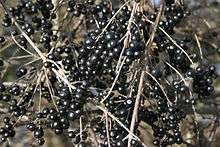Ligustrum vulgare
| Ligustrum vulgare | |
|---|---|
.jpg) | |
| Mature shrub in summer | |
| Scientific classification | |
| Kingdom: | Plantae |
| (unranked): | Angiosperms |
| (unranked): | Eudicots |
| (unranked): | Asterids |
| Order: | Lamiales |
| Family: | Oleaceae |
| Tribe: | Oleeae |
| Genus: | Ligustrum |
| Species: | L. vulgare |
| Binomial name | |
| Ligustrum vulgare L. | |
Ligustrum vulgare (wild privet, also sometimes known as common privet or European privet), is a species of Ligustrum native to central and southern Europe, north Africa and southwestern Asia, from Ireland and southwestern Sweden south to Morocco, and east to Poland and northwestern Iran.[1][2][3][4][5]

It is a semi-evergreen or deciduous shrub, growing to 3 m (rarely up to 5 m) tall. The stems are stiff, erect, with grey-brown bark spotted with small brown lenticels. The leaves are borne in decussate opposite pairs, sub-shiny green, narrow oval to lanceolate, 2–6 cm long and 0.5–1.5 cm broad. The flowers are produced in mid summer in panicles 3–6 cm long, each flower creamy-white, with a tubular base and a four-lobed corolla ('petals') 4–6 mm diameter. The flowers produce a strong, pungent fragrance that many people find unpleasant. The fruit is a small glossy black berry 6–8 mm diameter, containing one to four seeds. The berries are poisonous to humans but readily eaten by thrushes, which disperse the seeds in their droppings.[4][5][6]
Plants from the warmer parts of the range show a stronger tendency to be fully evergreen; these have sometimes been treated as a separate variety Ligustrum vulgare var. italicum (Mill.) Vahl,[5] but others do not regard it as distinct.[1]
In the British Isles it is the only native privet, common in hedgerows and woodlands in southern England and Wales, especially in chalk areas; it is less common in northern England, Scotland, and Northern Ireland, where it only occurs as an escape from cultivation.[5][7][8]
Cultivation and uses
The species was used for hedging in Elizabethan gardens in England, but was superseded by the more reliably evergreen introduction L. ovalifolium from Japan.[7]
A number of cultivars have been selected, including:[5]
- 'Aureum' – yellow leaves.
- 'Buxifolium' – small, oval leaves not over 2.5 cm long.
- 'Cheyenne' – cold-tolerant clone selected in North America.
- 'Chlorocarpum' - berries green.
- 'Insulense' – long, narrow leaves 5–11 cm long and 1-2.5 cm broad.
- 'Leucocarpum' – berries greenish-white.
- 'Lodense' – dense, dwarf shrub (the name is a portmanteau of 'low' and 'dense').
- 'Pyramidale' – fastigiate.
- 'Xanthocarpum' – berries yellow.
Invasiveness
The species is listed as invasive as an introduced plant in Australia,[9] Canada,[10] New Zealand,[11] and the United States.[12][13] It is also fully naturalised in Mexico's highlands[14] and Argentina.[15]
Gallery
References
| Wikimedia Commons has media related to Ligustrum vulgare. |
- 1 2 Flora Europaea: Ligustrum vulgare
- ↑ Plants for a Future: Ligustrum vulgare
- ↑ Germplasm Resources Information Network: Ligustrum vulgare
- 1 2 Blamey, M. & Grey-Wilson, C. (1989). Flora of Britain and Northern Europe. ISBN 0-340-40170-2
- 1 2 3 4 5 Bean, W. J. (1978). Trees and Shrubs Hardy in the British Isles vol. 2: 576-577. ISBN 0-7195-2256-0.
- ↑ Flora of Northwest Europe: Ligustrum vulgare
- 1 2 The Reader's Digest Field Guide to the Trees and Shrubs of Britain p.52.
- ↑ Flora of Northern Ireland: Ligustrum vulgare
- ↑ Potential Environmental Weeds in Australia: Appendix C
- ↑ Canadian Botanical Conservation Network: Information on Invasive Shrub and Vine Species
- ↑ Protecting and Restoring our Natural Heritage: Appendix one: Invasive weeds
- ↑ Swearingen, Jil; Reshetiloff, K.; Slattery, B; Zwicker, S. (2010). Plant Invaders of Mid-Atlantic Natural Areas, 4th Edition (PDF). National Park Service and U.S. Fish & Wildlife Service. p. 71.
- ↑ Invasive species: European privet
- ↑ Plantas medicinales. Virtudes insospechadas de plantas conocidas. 1987. Reader's Digest México S.A. de C.V. Printed by Gráficas Monte Albán S.A. de C.V. Querétaro, Mexico. ISBN 968-28-0099-4
- ↑ Gavier-Pizarro, Gregorio I.; Kuemmerle, Tobias; Hoyos, Laura E.; Stewart, Susan I.; Huebner, Cynthia D.; Keuler, Nicholas S.; Radeloff, Volker C. 2012. Monitoring the invasion of an exotic tree (Ligustrum lucidum) from 1983 to 2006 with Landsat TM/ETM+ satellite data and support vector machines in Cordoba, Argentina. Remote Sensing of Environment. 122: 134-145.




